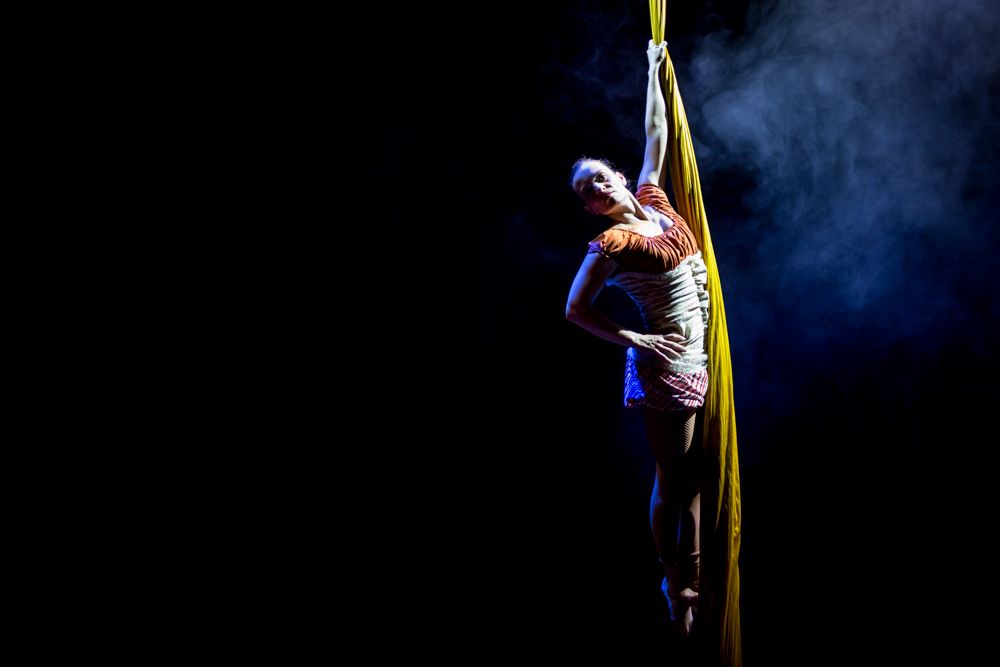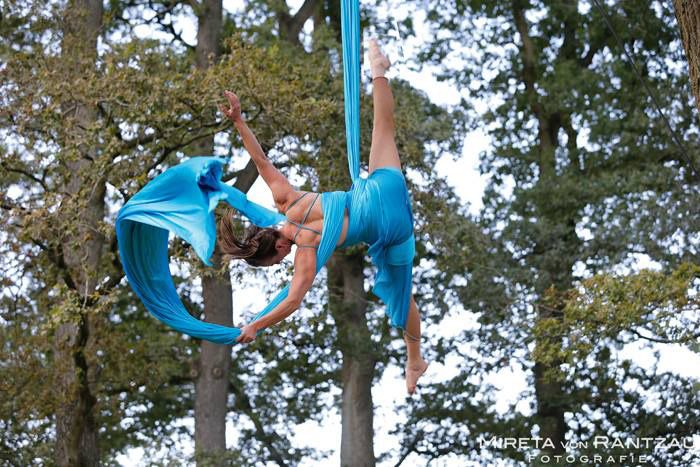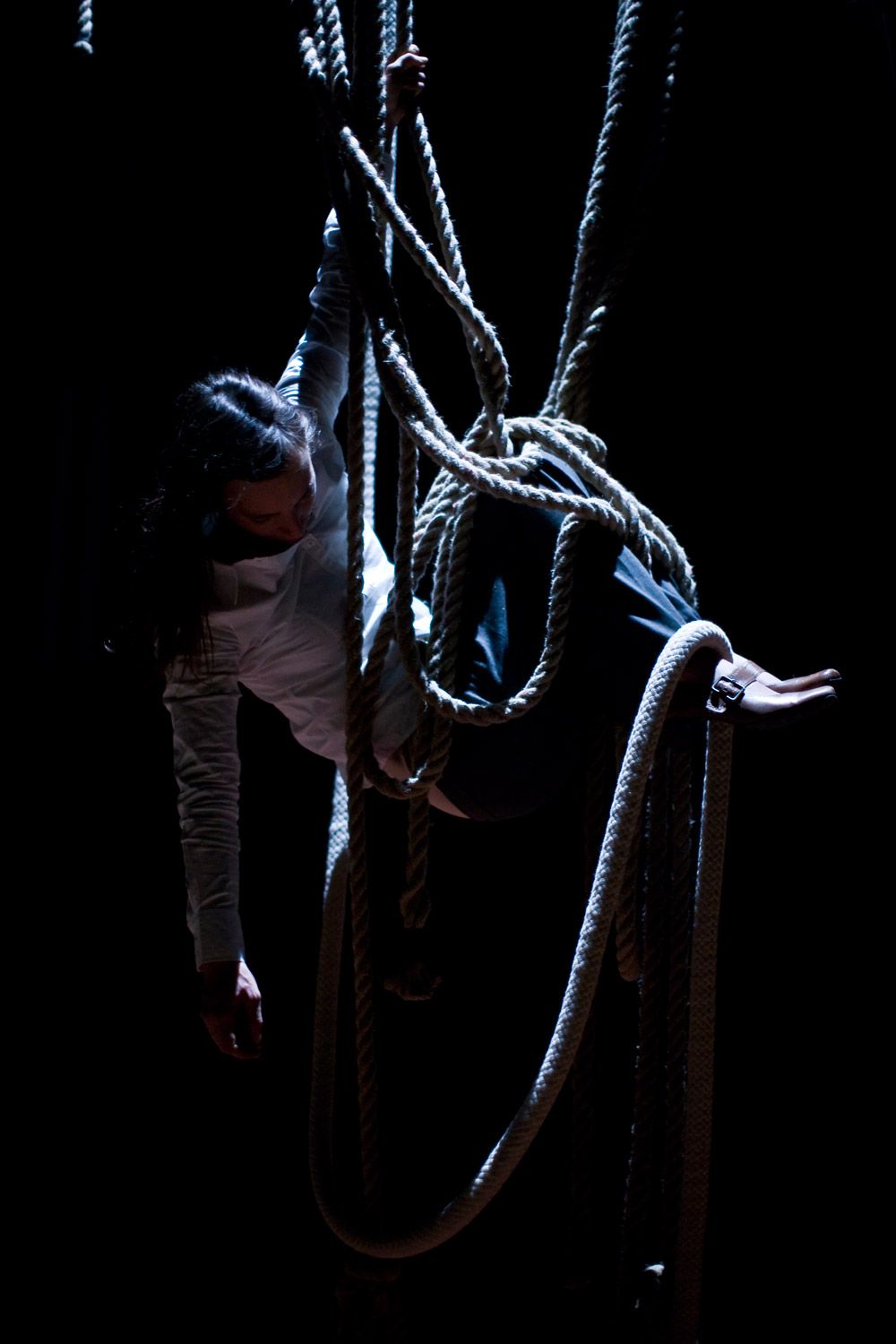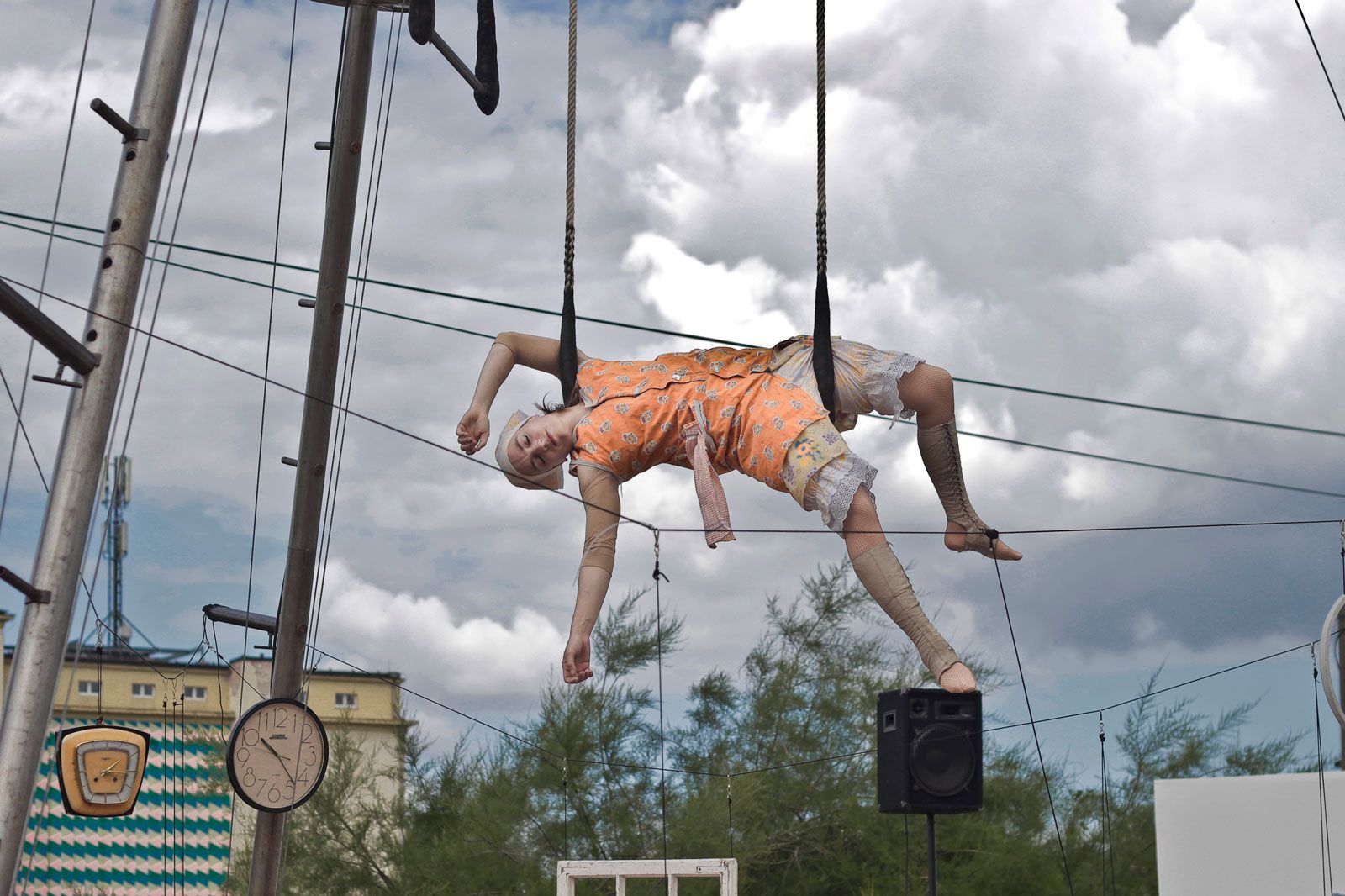I´m very excited to introduce Jana Korb, a well-known aerial theater artist from Germany. Jana has many performance projects and is performing all over Germany and neighboring countries. She is also the organizer of the Aerial Arts Festival in Berlin.
1. Dear Jana, could you please tell me a bit about yourself, what brought you to aerial arts?
I came to aerial acrobatics from gymnastics and climbing – sports. I moved to Berlin from Munich, where I had the mountains, and I came to Berlin where I needed something that was high up. Somehow I ended up doing trapeze, which I really love.
2. How have you developed your style as an aerial artist?
Style. It is a long process, I will always be developing my style. I have studied cultural science and fine arts, and Russian. I was doing acrobatics and aerial arts as a sport during the university years. Then I started changing my artistic creation: within fine arts I explored more and more performance arts, and from there I went to street art and circus art. I always wanted to tell stories and my language was my body, and I was still doing a lot of sports. In the process I actually started to put my art and sports together – art plus sports equals circus, doesn’t it!
I never used to consider myself a circus performer – I always said that I am doing aerial arts, not circus arts. Just lately I started calling myself a circus artist. This was a political decision, to add to the visibility of circus in Germany – but my heart is into theater and aerial theater.
I have always wanted to tell stories and my language is my body. I am inspired by Kabakov, Pivovarov and other artists from Moskovsky Romanticheskiy Conceptualism. My first piece worked very much in the style of this conceptual art. For me this is also connected to Czech experimental theater and Czech Surrealism.
Another thing that is immensely important to me, is to create stories about and from women. So I mostly take women’s points of view, empowering stories about women. So I consider my style feminist as well – hoping not to produce Agit Prop.
3. You perform a lot on trapeze. What makes trapeze special for you?
For me the trapeze is not so much an object, but space. Space where everything is possible, though it is very confined. So I create theater for a confined space. This spacial aspect is much stronger on the trapeze than on silks or rope, where the space is not so defined. I create in this space and for this space.

Foto: Vojtěch Brtnický
But a trapeze also is very specific equipment. Everybody sees it as a circus prop. That makes it hard to transcend it – unlike a rope, a rope can be anything – it is not tied to the circus.
But compared to other apparati, the trapeze is very pure. Silks are messy, I love training and performing with them. But for me it is hard to create on silks.
I just love the trapeze. It is a specific space, I like creating for that space.
And what about aerial hoop?
I don’t love hoop as much as the trapeze. I perform with it (we just created a new piece with two counterweight hoops), but I am not too attached to it. Maybe it is because of the history of the hoop. Hoop comes from contortion, trapeze comes from athletics. I’m more an athlete than a contortionist…
4. Jana, could you please tell me a bit more about your projects?
I have different directions of creation: on one hand I create aerial theater and on the other – I do aerial shows. In my aerial shows I perform by being strong and beautiful. I create them for entertainment and show business – for earning money by being great at what I am doing.
Aerial theater is about creating art. I aim to get money for doing it, but I probably would do it anyway.
I have different companies for my creation. In our trio collective mosaique we do fire shows, aerial shows and walking acts. This is very good for entertainment, events, festivals, weddings etc.
In my other collective Korb + Stiefel I mostly create aerial theater. I created a few solos, but also produced pieces with more people.
With my aerial theater I create stories about women. My recent production is a story by Franz Kafka about a trapeze artist who never comes down to the ground.

Foto: Vojtěch Brtnický
Very important for me is my Vintage! Women! Varieté!: I researched women in circus that really existed and have created a documentary theater, where we perform as these women and tell their stories and recreate their circus tricks.
In circus there were so many interesting people who did wonderful things – but nobody knows about them. So I went to search for them. In circus they tend not to mention the names of the individual performers. They talk about the best flyers on earth but didn’t show the names. This is a slowly changing issue in contemporary circus.
This is my ongoing women-in-circus-project. With it goes an exhibition to give more background information about these women. I have created further solo performances and lecture performances, a film and shows as a M.C.
As I said, I like doing silks very much, but I don’t like the aesthetics. But I have created a new silks duet together with Sylvia from Sol’Air: The Sassy Jassy Sisters. We re-created aerial ballet from the 1920s. It is my first silks piece that I really love! Maybe because it is in the style of the Vintage! Women! Variete!
Apart from that I work in ensembles just as a performer. One is in Munich on a Chandelier, Eclair en l’Air. I also have cooperations with other aerialists to do duets and more.
I love performing as an aerialist being just strong and beautiful. In my aerial theater I work with themes that are about more than beauty.
5. Have you also performed on original aerial apparatus?
What other apparatus have you worked on?
I rather transcend existing apparatus than create new ones. For example, in Frau Vladusch I work on three trapezes. In the end I use them all together like a thick rope.
In Paper Dolls I work with ten ropes with silks technique.
For Vertigo (a production that we do not perform any more) I made a cover for my silks, so they could transform from being a covered rope to being silks. This might be my original apparatus – I have never seen anyone do it (or copy it ;-).
My friend from Sol’Air invented the Tissu-Trapeze – instead of ropes the bar hangs on silks. I work for her sometimes and we also created a duet on the Tissu-Trapeze.
And there is the chandelier company. Very much fun to work on a chandelier!

On silks I work in so many different groups, constellations, duets and companies, that I have a really big repertoire of choreographies and tricks. So it is very easy and fun for me to improvise on the silks. Unlike on the trapeze: I usually prepare a choreography in my head, because I only do my own work on the trapeze, I never work in groups.
As for the hoop, I feel I am too stiff for the hoop – or the hoop is too stiff for me…
6. What is the difference between the Varieté and Circus?
I don’t perform in circus. I only performed in one traditional circus. I did varieté – that was fun. But also it felt like having a nine to five job. I felt trapped doing the same every day for three month, without creating. I am happy to perform in varietés, because it’s a good job, but I couldn’t do it all the time.
That is the main difference to theater and street theater: I create my own things. In varieté I am a part of the big show.
I would love to create a whole show for varieté and it would be great to find a variete that will co-produce my work.
We have the Wintergarten hosting the Luftartistik Festspiele Opening Gala! My first show that I put together for a variete!
7. How about the safety during the performance?
Every space is different. In every space you have to check different things. For street performances I bring my own structure to set up.
And of course you have to know what you are doing.

Foto: Vojtěch Brtnický
8. I saw that you are also doing fire in the aerial hoop. What is the secret behind it?
Aerial hoop is the best for fire in the air, because it has more metal than inflammable material. But I have played with fire while working on silks as well.
When spinning in the hoop you have to watch the direction of the fire, because the wind from the spinning makes the fire move in a different way than on the ground.
I mostly eat fire in the hoop. The fire must always be above you, not below you, which is hard when you are upside down…
9. How much do you train, warm up and stretch?
This has changed a bit, because over the last few years I started travelling immensely much. Before that it was routine work: creating and training in winter and travelling in summer. This year from January to May I had about seven projects that I had to produce, create, train and rehearse. So I didn’t have time for real every day training. And it continued until the end of September.
So I had to find a new way to train every day, because I don’t have time to train two to four hours a day as I did before. So I am developing my training that I can do everywhere. Stretching and strengthening four to five times a week in hotels or wherever. Whenever I have a chance to train on apparatus I do that, but usually that means rehearsing rather than training.
10. Could you please tell me a bit more about your aerial theater?
How about Frau Vladusch and Kafka projects?
Creating Frau Vladusch was very biographic work. I wanted to work with Erica Ruhl as my director. So we started by talking, discussing, thinking. Then we slowly started working with the body and on the trapeze. It was a six months creation process.
My Kafka production has a very long process – almost 15 years. It started as an acrobalance duet with Anja Gessenhardt. Until now I have created four different shows about the same story. It is a story about a trapeze artist who lives on her trapeze and never comes down. This summer I was touring with my newest production – a solo on the trapeze. For my research I tried to “live” on the trapeze – the longest was for three hours. This was very interesting – you really get to know your trapeze.
11. How is your choice of the music?
The music depends on the piece. Ticking clocks in Frau Vladusch. For the Paper Dolls I worked with a musician. She did all the music, the vocals and the electronics. In Vintage! Women! Variete! we worked with historic music of the time.
The music depends on what I am creating. I prefer working with music without words, without text. Or I create my own text.
It is easier, when I receive music to create a piece. This sometimes happens for events. Then I just create a choreography to the music.
12. What is the best exercise to do the foot hang on the trapeze?
You have to stretch your legs and calves, so you’ll be able to reach the ground when bending forward with straight feet. You have to stretch the back side of your legs. And you have to be strong enough to do it against gravity. So you need to train your core. And then of course it is overcoming the pain of hanging by your feet.

Foto: Thomas Kelling
13. How about one hand hanging? What should you consider not to injure the shoulders?
Meathook, back meathook and one hand hangs are different tricks. So there are different tips for all of them.
For just hanging on one hand you have to be strong enough in the shoulder to pull your shoulders down, to take your chest out. Shoulders should be on the same level, arms behind the ears. So it should not look different whether you hang by one or two hands. It is about the strength in the shoulders and working your back muscles.
The meathook and the back meathook are totally different techniques. Pull your shoulders back and down. And keep tension in the belly, the core must be strong.
14. What tips can you give to the aerial students?
Don’t train with YouTube, train with a trainer, unless you know what you are doing. When I started there was no YouTube yet. So there was no danger that you see something and copy it in a wrong way.
Another thing – have respect for danger. If you are not afraid, because you are not a scared person, respect is very important. People who don’t have respect are those who fall.
15. What are the most common mistakes on trapeze?
Students tend to hang with relaxed shoulders, which can hurt them very badly, especially when they are beginners and don´t have the strength in the shoulders yet. So always work with your shoulders.
And also as I just said, people, who don’t have respect and who are not afraid of height, get hurt easily. People who think that it’s fun to let themselves fall down, because there is a nice crash mat. Falling is a technique to learn as well.
16. Where one can book you for a show?
To book me you can contact my manager Lena – see my website.
janakorb.de
aerialartsfestival.de
vintage-woman-variete.blogspot.de
mosaique-feuershow.de
 Ballet exercises for aerialists with Severine Reisp
Ballet exercises for aerialists with Severine Reisp Interview with Anne-Sophie: Circus scene in Argentina
Interview with Anne-Sophie: Circus scene in Argentina Talk About Aerial Training With Aurélie Bernard
Talk About Aerial Training With Aurélie Bernard